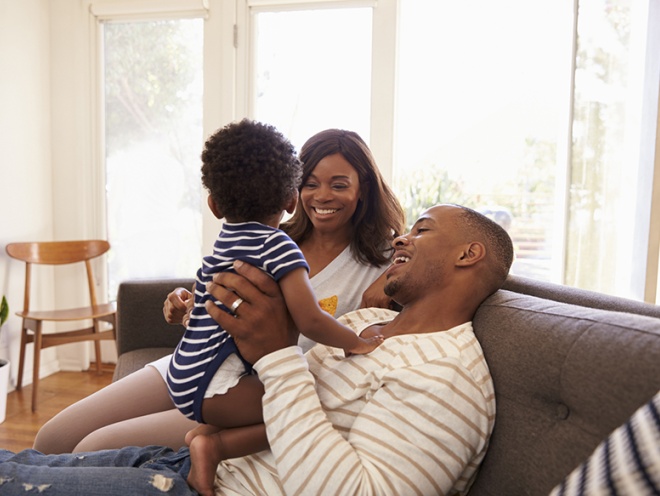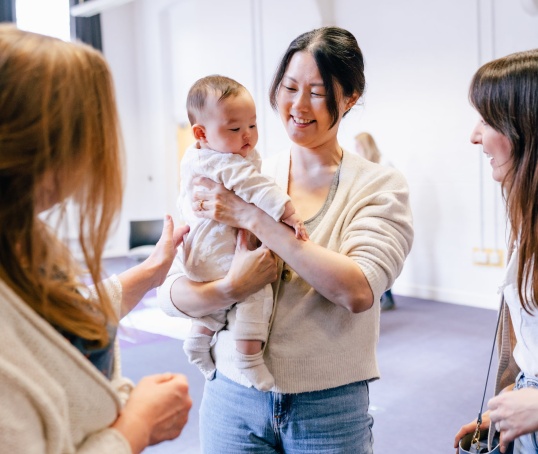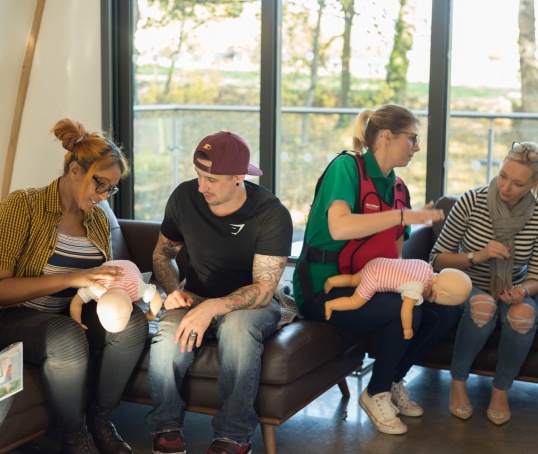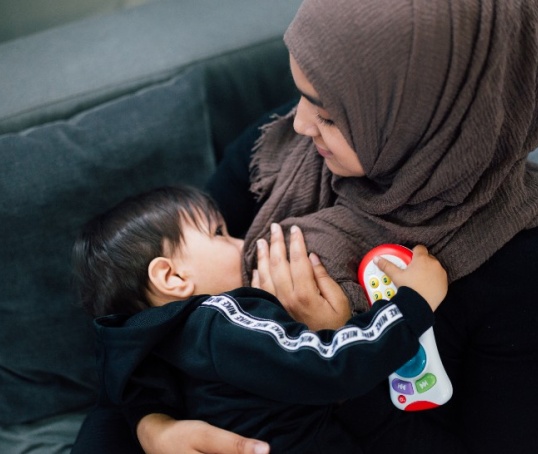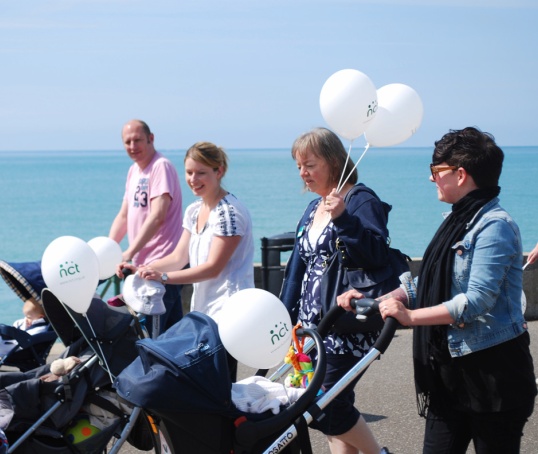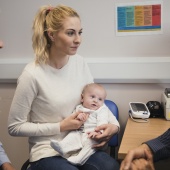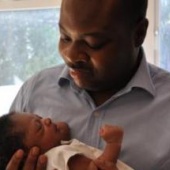While babies develop at different rates here are the milestones you might expect. Get ready for rolling, crawling, cruising and more.
Your baby will reach milestones at a rate that’s unique to them. They’ll get to each development stage when they are ready so try not to compare them with others.
It’s fascinating to see your baby grow and develop before your eyes. You will have plenty of exciting baby’s firsts to look forward to in the coming months. The following are the baby development stages you can expect.
Grasping and grabbing
Your baby can grasp an object like your finger from the moment they are born. At birth it’s a reflex and by the time they’re around three months old, it’s a skill they’re keen to develop.
You’ll notice your little one’s increased hand-eye coordination, as they discover their hands are part of their body and start to gain control over them (Murray, 2014).
As your baby develops their arm and hand muscles they will start to reach for objects (Public Health Agency, 2018). It’s a good idea to make sure hot drinks are out of their reach. Your little one will begin to reach accurately and quickly, not only with both hands but with their entire body.
By four months, your baby will probably have finally mastered this game and be able to get his thumb to his mouth and keep it there (Murray, 2014). Many people say this movement is one of the most important ways for your baby to self-sooth and calm down. So try not to cover your baby’s hands or prevent them from sucking their thumb if they want to.
Kick, wriggle and roll
If your baby enjoys kicking, wriggling and rolling, let them have enough space to move around. Make sure they aren’t constricted by clothing that’s too big or too small.
At first your little one’s movements may appear jerky and meaningless. If you observe your baby closely, you’ll see they are communicating through limb movements and facial expressions (Kelly, 2014).
Babies sometimes prefer to feel contained, recreating the feeling of being in the womb. Some babies might fling out their arms or try to push themselves up to the sides of their cot or Moses basket. This is a short phase. To create that security, you could tuck your baby in, or carry them in a sling.
Rolling over is usually the next stage of baby movement. So be careful about putting your baby on a bed or a high surface in case they start demonstrating their new skill.
Tummy time
Giving your baby supervised tummy time will help them to strengthen their back, arm and neck muscles (Pin et al, 2007; Hewitt et al, 2017; NHS Choices, 2017a; Wittmeier and Mulder, 2017). It also encourages them to roll over and get a different view of the world.
You can practice ‘tummy time’ with your little one once or several times a day (Pin et al, 2007; Hewitt et al, 2017; NHS Choices, 2017a). It’s best to do it when your baby is awake and alert.
Some babies don’t like being put on their tummies. This is perfectly normal and may change as your baby develops week by week (Pin et al, 2007; Hewitt et al, 2017; NHS Choices, 2017a). Read more in our article about tips for tummy time.
Sitting, crawling and bottom shuffling
Babies learn to sit, first supported and then unsupported (Public Health Agency, 2018). Your little one might enjoy holding your hands and attempting to pull up to a sit.
Some babies find it difficult moving from sitting to crawling and they can hurt themselves. Your baby might get stuck, so it’s a good idea for someone to be close by and keep an eye on them.
When your little one decides to crawl for the first time, it’s likely to be towards something or someone that interests them. You can encourage them by putting a favourite toy just out of their reach, or by calling them from a few paces away.
Try to place your baby on a soft blanket or carpet and be prepared for them to wobble a little. As they may still be too young to support their own body weight on their arms.
Some babies crawl sideways, backwards, or even with one knee up. Others will shuffle around on their bottom instead of crawling, this is normal for some babies.
If your little one is a bottom-shuffler they may propel themselves using one hand and one leg or both hands and legs. They might even bounce themselves along.
Standing and cruising
Some babies will crawl for months before walking, others may move on quickly (Public Health Agency, 2018). You can encourage your little one to walk by supporting their underarms with your hands and bouncing them up and down. You might notice them stiffen then relax their legs, stand on their tip toes and sometimes resist being put down.
At this age your baby might stand up and not know how to get back down, so they may call out for help. You can teach them to lower themselves onto their bottom by pushing them down gently.
Once your little one has learned how to stand, it won’t be long until they are cruising. This is when your baby starts grabbing onto furniture to pull themselves up and for support as they shuffle along a few steps (NHS Choices, 2017b). So always keep hot drinks out of reach.
Cruising is one of your baby’s last steps to walking completely independently. Remember some slips and falls are inevitable and all part of learning.
In the beginning, your baby might walk with their feet at a slight angle; this can happen while the muscles in their legs get stronger (NHS Choices, 2017b). If this continues, seek advice from your GP.
It’s a good idea to do another baby safety check around your house. You might need to move small items up another level out of your baby’s reach or put them away. Make sure that any dangerous items like cleaning products are out of your baby’s reach.
Walking
Some babies will spend plenty of time cruising as they gain confidence, while others quickly move on to walking. Learning to walk is a huge baby milestone.
Seeing your little one take their first steps on their own is an incredible feeling and they will be delighted too. Before you know it they will be running, jumping and skipping, and you will be chasing after them.
Baby milestones
Babies will choose when they feel comfortable rolling over, sitting, crawling, standing or walking.
If your little one is learning a new skill, it’s better to leave them to master that stage of development rather than push them onto the next milestone (Plooij and van de Rijt, 2013).
Sometimes your baby may seem to lose a skill due to concentrating on gaining a new ability. Once they have mastered the new skill, you will see that the old ones are still present (WHO, 2006).
Similarly, if your little one is ill, they might temporarily regress with their movement. As soon as they’re feeling well again, they’ll have the energy to pick up where they left off (WHO, 2006).
There’s no rush, most babies will do things when they’re ready. You can help by making sure they can move around and practice their new abilities freely, easily and safely.
This page was last reviewed in October 2017.
Further information
Our support line offers practical and emotional support with feeding your baby and general enquiries for parents, members and volunteers: 0300 330 0700.
We also offer antenatal courses which are a great way to find out more about birth, labour and life with a new baby.
Make friends with other parents-to-be and new parents in your local area for support and friendship by seeing what NCT activities are happening nearby.
Hewitt L, Stanley RM, Okely AD. (2017) Correlates of tummy time in infants aged 0-12 months old: A systematic review. Infant Behav Dev. 49:310-321. doi: 10.1016. Available from: https://www.ncbi.nlm.nih.gov/pubmed/29096238 [accessed 1st October 2017].
Kelly K. (2014) The fourth trimester. Essentially MIDIRS 5.(4):24 – 28. [accessed 1st October 2017].
Murray L. (2014) The psychology of babies. London, Constable & Robinson. [accessed 1st October 2017].
NHS Choices. (2017a) How to keep your baby or toddler active. Available from: https://www.nhs.uk/conditions/pregnancy-and-baby/keeping-kids-active/#why-tummy-time-is-important [accessed 1st October 2017].
NHS Choices. (2017b) Leg and foot problems in children. Available from: http://www.nhs.uk/conditions/pregnancy-and-baby/pages/leg-and-foot-problems.aspx [accessed 1st October 2017].
Piek JP. (2006) Infant Motor Development. Windsor, Human Kinetics. [accessed 1st October 2017].
Pin T, Eldridge B, Galea MP. (2007) A review of the effects of sleep position, play position and equipment use on motor development of infants. Development Medicine and Child Neurology. 49:858-867. Available from: https://www.ncbi.nlm.nih.gov/pubmed/17979866 [accessed 1st October 2017].
Plooij F, Van de Rijt H. (2013) The Wonder Weeks. London, Kiddy World Publishing. [accessed 1st October 2017].
Public Health Agency. (2018) Birth to five. Available from: http://www.publichealth.hscni.net/publications/birth-five [accessed 1st October 2017].
WHO (2006) WHO Motor Development Study: Windows of achievement for six gross motor development milestones. Acta Paediatrica Supplement. 450:86-95. Available from: https://www.ncbi.nlm.nih.gov/pubmed/16817682 [accessed 1st October 2017].
Wittmeier K, Mulder K. (2017) Time to revisit tummy time: A commentary on plagiocephaly and development. Paediatrics & Child Health (1205-7088). 22(3):159-161. Available from: https://www.ncbi.nlm.nih.gov/pubmed/29479204 [accessed 1st October 2017].
